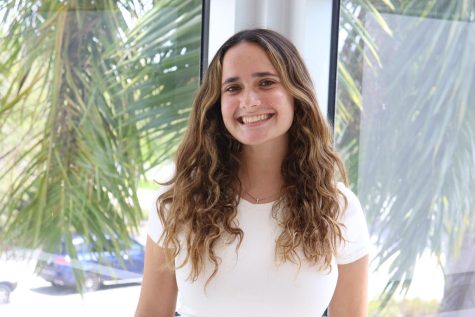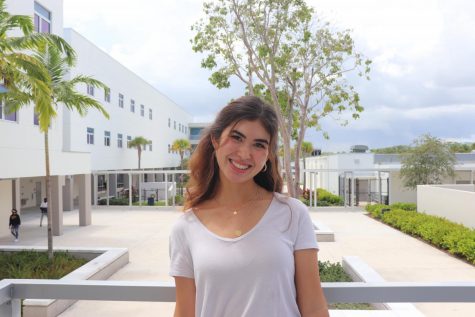Would a Hybrid Schedule Be Beneficial? (FACEOFF)
October 10, 2020
Samantha: No
During these unprecedented times, no one knows how to approach going back to school. The school district, parents, students and the government all have something to say — no answer is completely right or wrong.
Many people who have health conditions or live with at-risk family members have taken extra precautions throughout the pandemic, such as deciding to attend school online. Some students not as concerned with COVID-19 have tried to continue with life. Many students with health conditions opted for online school because uncautious students and staff sometimes do not wear their mask, putting them at risk. The tough question continues to be whether a mix of both would be best. Though it sounds like the perfect solution, attending hybrid school, a mix of both, would cause students to have more exposure to the virus, make teaching difficult and make it harder for students with learning disabilities to effectively learn.
A proposed model is hybrid school, where groups of students attend school on alternating schedules to maintain social distancing guidelines. Some think this option may work because it gives the sense that life is slowly adjusting to how it once was, giving students the best of both worlds. In reality, hybrid schooling prolongs things ever going back to normal due to the increase of interaction. As it opens up, students and teachers become in contact with more people increasing the chances of an outbreak.
Many already have a schedule in place that works with online school, and going back in person could bring even more chaos in their lives. Hybrid schooling also leaves students with less time to interact with their teachers and learn in class. Depending on a school’s hybrid plan, some students may not go to school two or three days a week. During this time, students may go out to see others, increasing the risk of contracting or spreading the virus and then bringing that back to school a few days later.
Teachers also have to juggle teaching two audiences: the in-person students and online students. With this difficult teaching style, it may be difficult to adjust to and leave students confused. Along with that, teachers cannot hand out papers and need more caution while walking around the classroom. While this paperless approach supports a sustainable environment, in-school students should not continue to do work virtually for it is not practical. Staying online would have the same result.
Hybrid learning is especially difficult for students with learning disabilities. Students with learning disabilities will have to rely on family members to help them if they do not understand the lesson, which takes parents time away from their own work.
If all students went to school, they would be in contact with teachers, faculty and other students. A hybrid schedule would also expose students to an additional group because on off-days where they do not attend school, they have to be watched by someone. Epidemiologists argue that students staying completely virtual limit the number of people they come into contact with, while a hybrid schedule would increase it.
In the end, a hybrid schedule exposes both students and teachers to more people, meaning that they would have a greater chance of contracting or spreading the virus. Staying completely virtual limits the students’ interactions with others — setting the course for cases to drop and life to go back to normal much quicker.
Katriona: Yes
School districts across the country and world face a difficult choice: send students back to school in-person or continue classes virtually. Districts must take into consideration quite a few factors, as each side has significant drawbacks. Only one solution, a hybrid schedule, offers an effective compromise that minimizes each side’s drawbacks.
To begin, reopening schools for in-person classes presents major health risks, as COVID-19 still poses a very real threat to public health. Schools have no way to guarantee the safety of every teacher, student and administrator — even with the implementation of costly, time-consuming safety measures such as purchasing personal protective equipment or reorganizing hallway flow. The risks of reopening have been repeatedly highlighted with cautionary tales from schools that reopened early and abruptly had to close back down due to a COVID-19 outbreak, such as this middle school in Greenfield, Indiana.
On the flip side, a virtual education is nowhere near as effective as an in-person one; in June, the New York Times reported that research predicts some students will have lost the equivalent of a full year of learning due to school closures that began in March 2020. These students tend to come from lower socioeconomic backgrounds, as virtual learning does not impact all students equally and only serves to exacerbate the achievement gap between wealthy students and poorer ones; wealthy students have extra resources to compensate for any lost education. Additionally, during school closures, students reported feeling more isolated and lonely, as schools play a crucial role in helping students form and maintain friendships.
Districts have wrestled with this to-open-or-not-to-open dilemma since schools first closed, but many, including the nation’s largest, New York City Public Schools, have come up with the same solution, a compromise of sorts: a hybrid schedule.
A hybrid schedule means students spend part of their time learning in the classroom and part of the time learning from home. Hybrid schedules take a couple different forms: some mean coming in every other day or week, while others entail coming in for half the day. Either way, a hybrid schedule has considerable advantages for students.
From a safety standpoint, students will be exposed to others for only half the normal amount of time, significantly lowering the chances they will infect or be infected by others. Additionally, it gives schools time to clean and sanitize surfaces before more students come in.
From an education standpoint, it provides students with at least a little time to learn more effectively, catch up, make friends and build relationships with teachers.
While not perfect, hybrid schedules draw from the best of both worlds: students receive an in-person education, giving them the opportunity to interact with teachers and classmates (from a distance), but also keep students safer than if they were to go to school in-person full-time.








